Huawei recently unveiled the Nova 3 in India, an affordable flagship priced at Rs. 34,999, adding a new contender to the likes of the OnePlus 6, the Asus ZenFone 5Z and the Honor 10. Much like the other affordable flagships in the market today, the new Huawei Nova 3 packs in top-of-the-line specifications at a relatively affordable price, making it a compelling competitor in the race to take the crown for the best affordable flagship. But does the flagship hardware included in the device actually live up to the company’s hype? Or is it just another wannabe flagship killer that’s trying to get a piece of OnePlus’ market in the country? If you’re been asking these questions yourself, then you’ve come to the right place, as here we’ll be taking an in-depth look at the Huawei Nova 3 to find out if Huawei’s claims have any substance or if it’s just marketing mumbo-jumbo to mislead the consumers.
Huawei Nova 3 Specifications
Being an affordable flagship, the Huawei Nova 3 packs in top-of-the-line hardware to deliver the best performance, while cutting corners in a few areas which aren’t as essential to the average consumer. Let’s take a look at the hardware specifications of the Huawei Nova 3, before we move on to the review:
| Display | 6.3-inch 2340x1080p IPS LCD |
| Processor | Hisilicon Kirin 970 |
| RAM | 6GB |
| Storage | 128GB |
| Primary Camera | 16MP f/1.8 + 24MP f/1.8 (monochrome) |
| Secondary Camera | 24MP f/2.0 + 2MP |
| Battery | 3,750mAh |
| Operating System | EMUI 8.2.0 based on Android 8.1 Oreo |
| Dimensions & Weight | 157 x 73.7 x 7.3 mm, 166gm |
| Price | Rs. 34,999 |
What’s In the Box
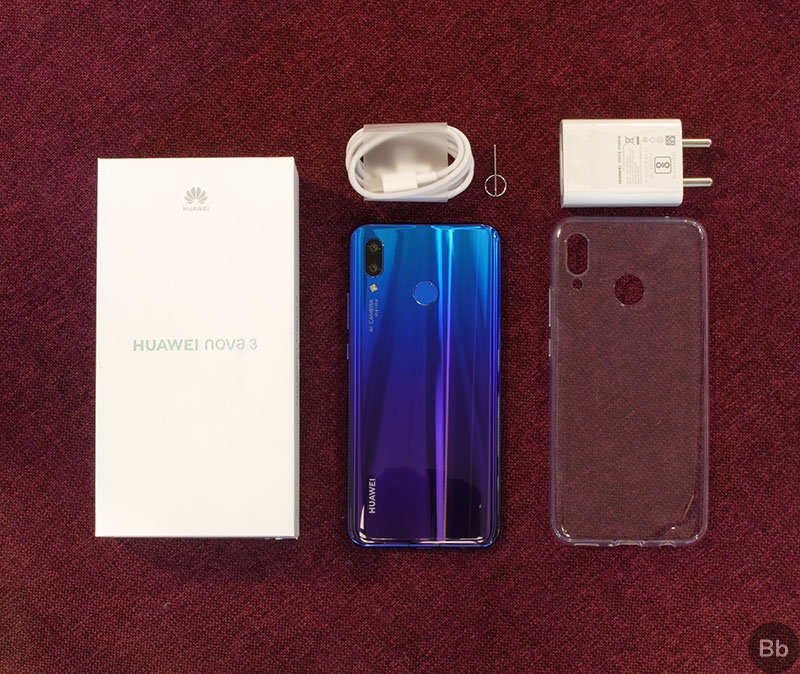
For the purpose of this review, we received the Iris Purple variant of the Huawei Nova 3 that comes in a minimal white box that has the device’s name written up front. Inside the box, Huawei has included the regular set of accessories, including:
- 9V/2A charging brick
- USB Type-A to USB Type-C cable
- Clear case
- SIM ejector tool
- Paperwork
Design and Build Quality
Much like all other modern flagships the Huawei Nova 3 has a glass sandwich design, with the metal frame sandwiched between glass on both the front and back of the device. The front of the device looks like practically every other smartphone released in 2018, with an 19.5:9 bezel-less display and the familiar notch up top, which houses the earpiece, the dual front-facing cameras, an LED indicator neatly tucked within the earpiece and an IR emitter for improved face unlocking capabilities.
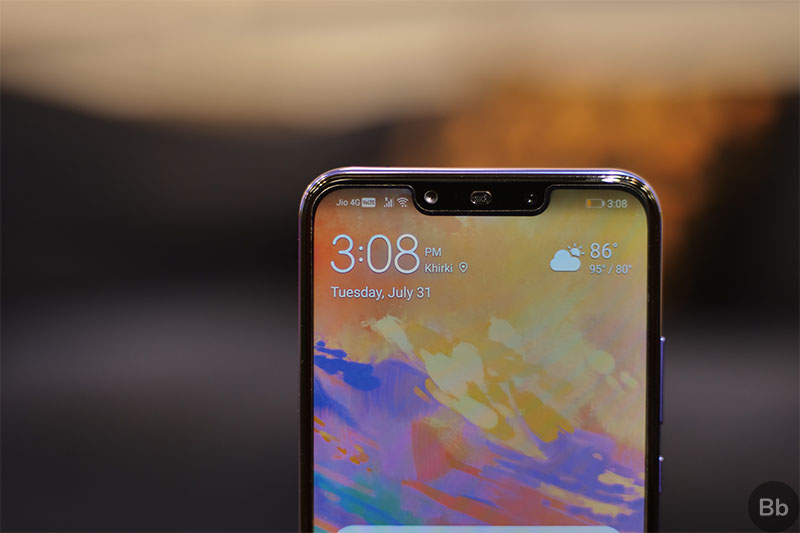
On the back, the glass has a shimmery dual-tone finish that changes colors depending on the angle at which you look at the device. Personally, I found it a bit tacky as it isn’t as subtle as the finish found on Huawei’s flagship P20 Pro, but a number of people around the office liked it as it made the device stand out. Bang in the center of the back lies the circular fingerprint sensor, with the vertically oriented dual camera setup placed on the top right corner, along with an LED flash underneath.
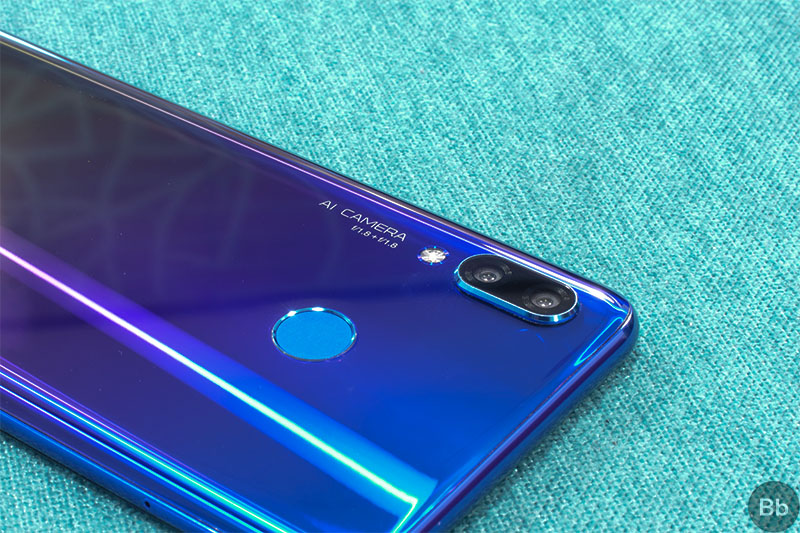
Both the power button and the volume rocker reside in a comfortable position on the right edge of the device, with the power button sporting a slight texture which will allow you to differentiate it from the volume rocker. The buttons are made up of metal and have a great tactile feel which gives the device a really premium feel.

Up on top, the device just has a tiny hole for the secondary microphone, while the SIM card slot resides on the left edge of the device. The Nova 3 includes a hybrid dual-SIM tray which will allow users to either install two SIM cards or one SIM card and a micro-USB card for expansion.
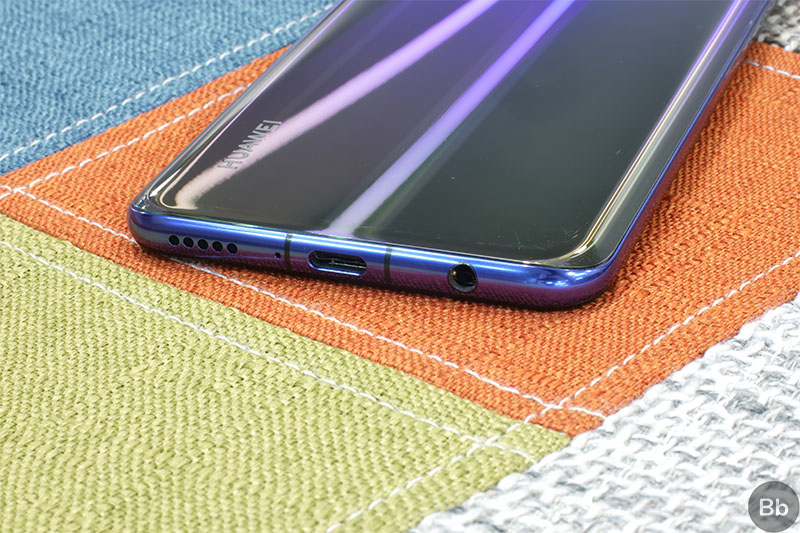
The bottom edge of the device houses a single speaker, the primary microphone, a USB Type-C port for charging and data syncing, and a 3.5mm headphone jack. The Huawei Nova 3 has a very modern design and premium build quality, befitting any flagship device launched in 2018. It’s only shortcoming is that it’s extremely slippery, but that can be easily solved by slapping on a case or a skin, which you’d probably do as soon as you get the device.
Display
The Huawei Nova 3 sports a 6.3-inch IPS LCD display with a resolution of 2340×1080 pixels, giving it an aspect ratio of 19.5:9. At first, I was disappointed that the device didn’t include an OLED display, but upon using it for a couple of days I realized that it wasn’t all that bad. The display can get fairly bright, aiding in sunlight visibility, and it looks quite vibrant out of the box. In case you don’t like the default color profile, Huawei also gives you the option to customize it according to your personal preference through the color mode and temperature settings in the display menu.
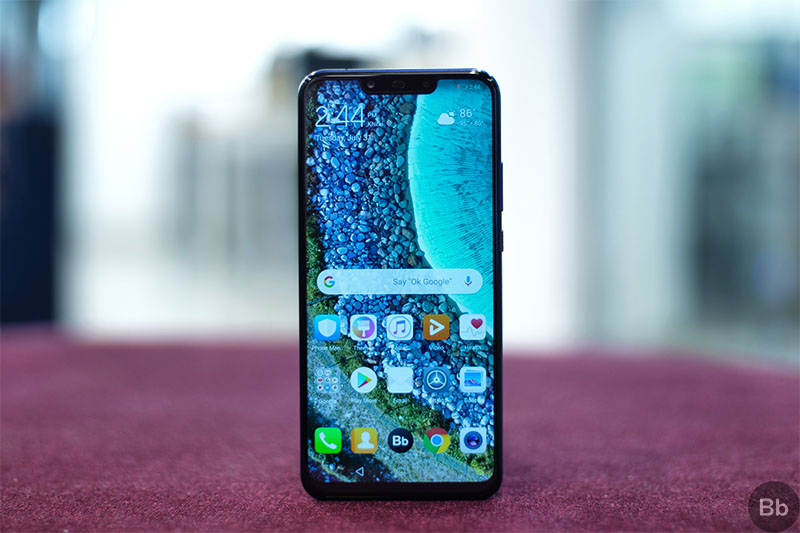
One minor flaw that I found with the display is that the area around the notch is slightly darker than the rest of the display, possibly because the backlight can’t reach the edges properly. However, I got used to that in no time and it wasn’t a major hinderance in any way. While I wish Huawei would have included an OLED panel on the Nova 3, the included LCD isn’t all that bad and if you haven’t used a smartphone with an OLED display before, you won’t have any problems adjusting to the lower contrast ratio.
Speakers and Audio
The single bottom firing speaker on the Nova 3 isn’t all that loud and it can get easily muffled while using the phone in the landscape mode. It’s not bad, per se, but it isn’t good either and I’ve definitely heard better smartphone speakers before. I wish Huawei had placed the speaker in a different location or included a better speaker unit, which would have greatly improved the phone’s overall sound output.

Audio quality in calls is pretty great, which is a given if you’re investing in a smartphone at this price point. I had absolutely no qualms with the call quality either and the receiver also heard me quite clearly. Due to the average speaker included in the device, using the speakerphone during calls wasn’t a great experience and it could have been improved significantly had Huawei included a better speaker.
Cameras
The cameras on the Huawei Nova 3 are probably its strongest suit, with both the rear and front dual camera setups performing incredibly well in our testing.
Rear Cameras
The Nova 3 packs in a 16MP f/1.8 primary sensor with phase detection auto-focus which is complemented by a 24MP f/1.8 monochrome sensor to enhance the image quality and assist in portrait mode photography. Images captured with the smartphone in ample amount of light turn out pretty great, with good detail, high dynamic range and vibrant colors. The camera is snappy and the AI assist feature really works wonders, allowing users to just point and shoot images without worrying about any settings. Take a look at some of the images clicked using the Nova 3 in decent lighting conditions:
Thanks to the monochrome sensor and the AI assist feature, the Nova 3 also performs quite well in low-lighting conditions, capturing a surprisingly good amount of light. Images captured in low-light conditions have surprising amounts of detail with great dynamic range and little to no noise. I was truly impressed with the camera’s low-light performance as it even manages to capture decent images when it’s almost pitch black. Just take a look at these camera samples and see for yourself:
As expected, the Nova 3 has a portrait mode as well which delivers great images time and time again. Portrait images captured using the rear camera setup have a great bokeh effect and decent edge detection, with the camera slightly faltering in low-light conditions. Portrait images captured using the camera are definitely usable and might even be better than those captured by its competitors. Just take a look at these samples:
Interestingly, the Nova 3’s secondary monochrome sensor can be used on its own to capture stunning black and white images. Photos captured by the monochrome sensor are arguably better than those captured by the primary sensor and have better dynamic range and significantly more details. Here are a few comparative samples captured using the monochrome and color sensors:
Front Cameras
Up front, the Huawei Nova 3 packs in a 24MP f/2.0 primary sensor along with a 2MP secondary sensor for depth perception. Unsurprisingly, images captured using the front facing cameras turn out great, with a good amount of detail and vibrant colors. The front camera setup also has a portrait mode option which is capable of capturing decent portrait shots with good edge detection and a pleasant bokeh effect, provided you tap on the subject before you take the image. In case you don’t tap on the subject before taking the shot, the image turns out blurred.
One front facing camera feature/trick which really stood out in my time with the device was its ability to automatically change the camera UI to a very bright white in cases where there wasn’t enough light falling on the subject, which is probably the best implementation of a screen flash as it allows the user to see the image being clicked in real time. Overall, I was quite satisfied with the results and I’m sure you will also be sure once you take a look at the following samples:
All-in-all, the Huawei Nova 3’s four cameras are actually worth the hype and I would like to extend my heartiest congratulations to the company on achieving such standards at this price range. On the downside, however, the company needs to take a hard look at the camera UI and consider decluttering it a bit to make it easier to use for the average consumer. I would also really appreciate it if Huawei gave more important settings, like the monochrome and PRO mode, the center stage rather than promoting its useless AR lens and Qmoji features which aren’t that great.
Performance
Performance wise, the Huawei Nova 3 stacks up well against the best smartphones in the market today as it packs in the company’s flagship Kirin 970 processor, which can also be found on the P20 Pro, a smartphone almost twice the price of the Nova 3. For some reason, the review unit shipped with an unlocked bootloader which prevented us from installing any major benchmarking software on the the device. It seems like the company is worried about the device’s performance and how its flagship chipset stacks up against the Snapdragon 845 which powers most popular flagship smartphones.
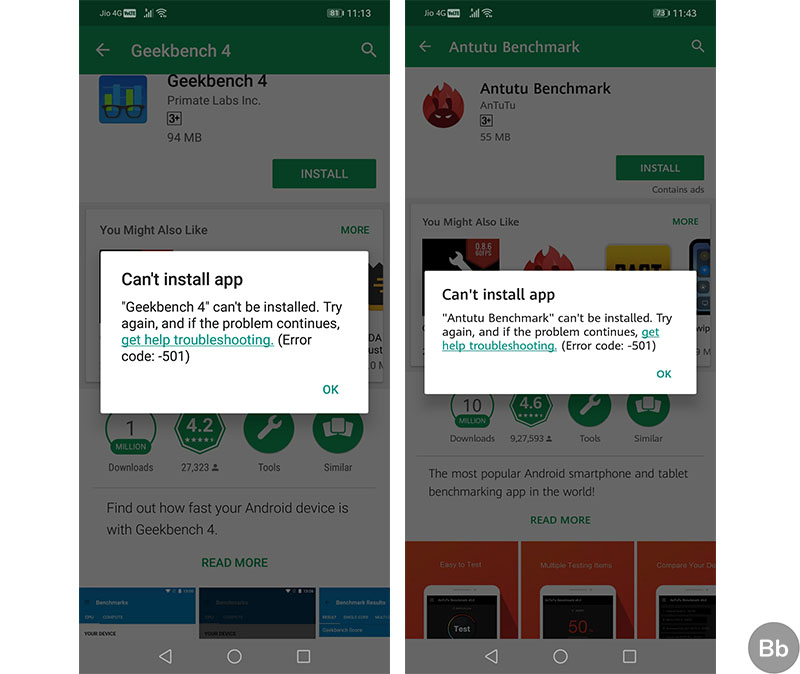
We reached Huawei regarding the same and were told that we’d receive an OTA update which will lift the limitations from the device, but we still haven’t received the update so far. Since we weren’t able to install any benchmarking software, we had to rely on the benchmarking scores of the P20 Pro which packs in the same Kirin 970 processor and 6GB of RAM. As expected, the Kirin 970 chip loses to most other flagships powered by the Snapdragon 845 as it’s a more recent flagship SoC. The P20 Pro was able to score 208797 in AnTuTu and in Geekbench 4 it was able to manage 1907 in single-core and 6817 in multi-core tests. The Kirin 970’s score pales in comparison to the OnePlus 6 and the Asus ZenFone 5Z, which is probably why Huawei chose to prevent us from installing any benchmarks on the device.

Benchmarks aside, the Huawei Nova 3 performed quite well in real world use, with the UI optimized well enough to deliver lag free performance at all times. The phone felt quite snappy, with apps taking minimal amount of time to load up and remaining in memory even when a number of demanding games were opened right after. The fingerprint sensor felt really snappy and the IR assisted face unlock feature also worked quite well, although it isn’t as fast as the face unlock feature on OnePlus devices which only makes use of the front facing camera.
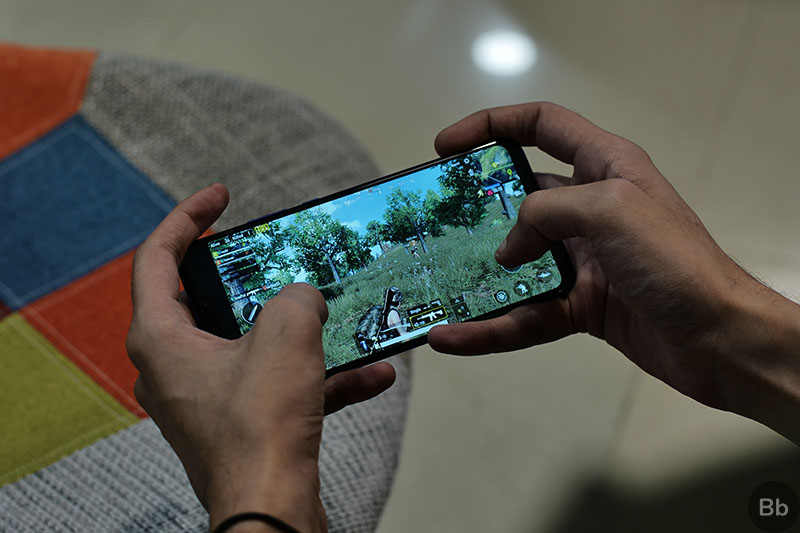
Gaming on the Huawei Nova 3 was also pretty great and I tried out a bunch of demanding games like PUBG Mobile, Shadowgun Legends, Asphalt 9: Legends, and Tekken, and the phone didn’t lag out on me even once. As expected, the games automatically selected the highest possible graphics settings each time and playing the games on the near bezel-less display was an immersive experience. Despite the fact that the Kirin 970 chip didn’t fare quite as well as the Snapdragon 845 in synthetic benchmarks, it’s still a capable chip and you surely won’t be disappointed by its performance.
Software
On the software side of things, the Huawei Nova 3 runs the company’s EMUI 8.2.0 based on Android 8.1 Oreo. I’ll admit that I’m slightly biased against any skinned versions of Android and I prefer a stock or near-stock Android experience over anything else, but I had absolutely no issues with Huawei’s custom skin in my time with the device. Much like other skinned versions of Android, EMUI is chock full of customization options which give users a number of features that they’d not find in stock Android, so if you’re into that you might like the Nova 3’s UI much more than I did.
EMUI also packs in features like “Huawei share” to share files with other Huawei devices, an eye comfort mode which reduces blue light emissions to prevent eye strains, and it even packs in an option hide the display notch. Huawei has also included a unique feature called HiTouch, which allows users to quickly look up products online with the help of Amazon Assistant. All you need to do is open the HiTouch feature within the camera app and tap the display with two fingers and you’ll be automatically taken to the product’s listing on Amazon.
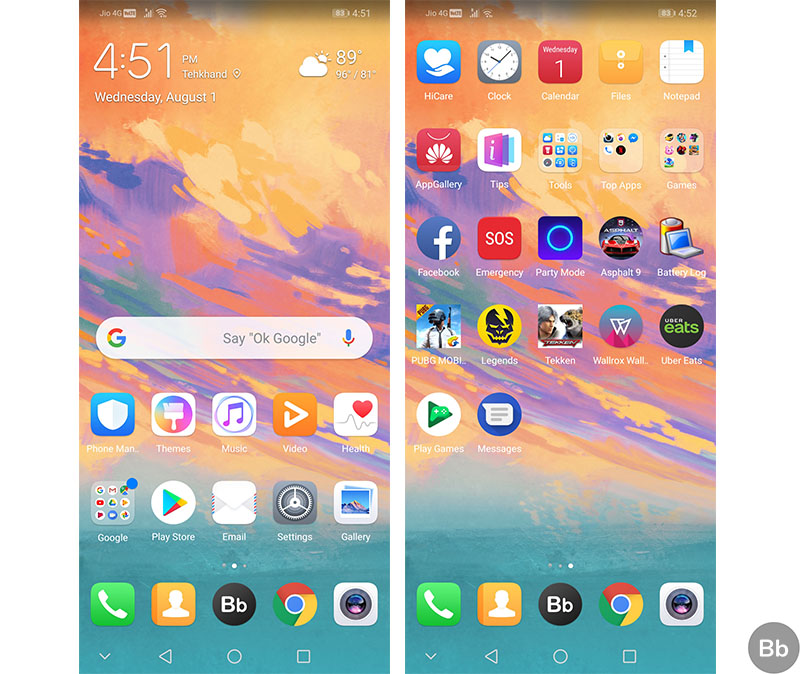
Huawei has also packed in full-screen gesture navigation on the device which makes use of a pill, like the one found on Android P. The gestures are quite fluid, but they aren’t as intuitive as the ones implemented by Xiaomi or Vivo, so I’d suggest that you stick to the usual navigation buttons for now. In case you don’t like the skinned UI as much, you can always install your favorite Android launcher, Nova (lol) being my go-to choice, and customize it completely to your personal preference. Since the software experience is quite subjective and differs from user to user, I won’t hold the customized UI design against Huawei as I faced absolutely no problem in my time with the device, despite the fact that I didn’t really like the looks of it.
Battery
The Huawei Nova 3 packs in a respectable 3,750mAh battery which is easily capable of powering the device through a day with medium to heavy usage. The device’s standby times are pretty great and in my testing the device lasted just over two days when I used it sparingly, clicking some photos, playing a few games and browsing the internet over brief intervals.
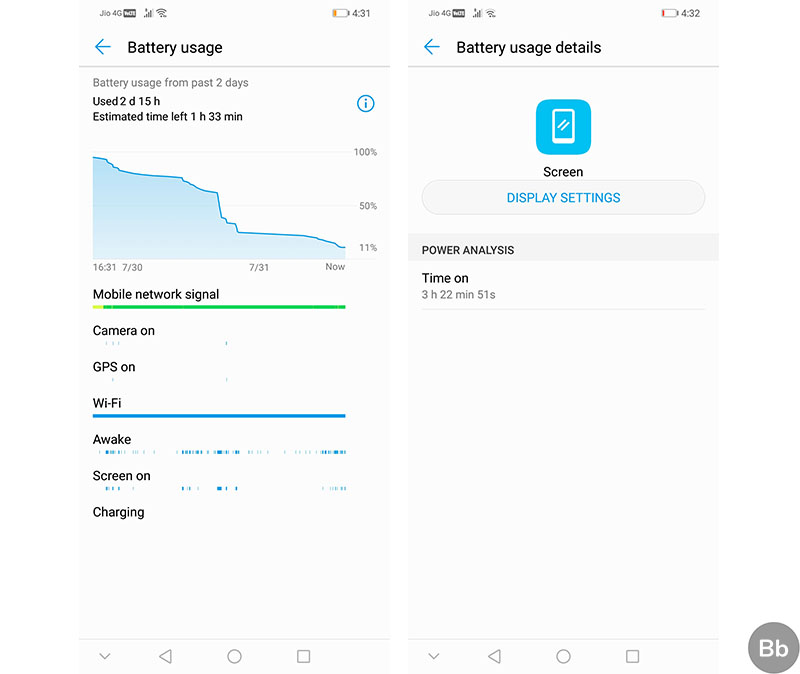
Even under heavy use, the battery is substantial enough to last a full day, with enough charge remaining to keep going for a couple of more hours. When I used the device extensively, it lasted just over 18 hours with a screen on time of over five and a half hours, which isn’t too shabby. In case you’re running low on battery and need to aggressively conserve whatever’s left till you reach a power point, Huawei has included two power saving modes which greatly increase the battery life of the device, but drastically limit its performance in the process.

The smartphone ships with a 9V/2A charging brick which is capable of charging the device quite quickly. In my testing, the device charged from 10 to 60 percent in an hour and forty five minutes, reaching 100 percent in a total of two hours and twenty five minutes. As you can already tell, charging the Nova 3 is a bit slow and it’s not even remotely close to charging speeds delivered by OnePlus’ Dash Charge technology. Another thing worth noting is that the smartphone charges rather uniformly, unlike other fast charging solutions which charge up the device pretty quickly up to 50 percent and then slow down a bit before reaching 100 percent. This means that the Nova 3’s charging solution isn’t exactly ideal for quick top-ups and you’ll have to charge the device for at least an hour if you want to get close to 50 percent charge on your device.
Pros:
- Premium design and build quality
- Great camera performance
- Good battery life
- Decent performance
Cons:
- Average speakers
- Cluttered camera UI
- Slow charging speeds
SEE ALSO: Asus ZenFone 5Z Review: Should You Buy Over OnePlus 6?
Huawei Nova 3 Review: Would Definitely Recommend!
In conclusion, the Huawei Nova 3 is a great affordable flagship which brings an amazing camera, good battery backup and decent performance to the table. Despite its poor benchmark scores, the Nova 3 might be the best affordable flagship in the market today and it stacks up quite well against other affordable flagships, like the OnePlus 6 and the Asus ZenFone 5Z. The smartphone really shines in the camera and battery life department, however, it does fall slightly behind in the performance and audio department. The OnePlus 6, with its OLED display and near stock Android UI, also delivers a better user experience.
If you’re interested in taking an in-depth look at how the device stacks up against the OnePlus 6 and the Asus ZenFone 5Z, keep a lookout for our comparison of the three devices. So, what do you think of the Huawei Nova 3? Do you think it has the potential to take down the OnePlus 6 as the next best affordable flagship? Let us know in the comments section below.
Buy from Amazon: (Rs. 34,999)








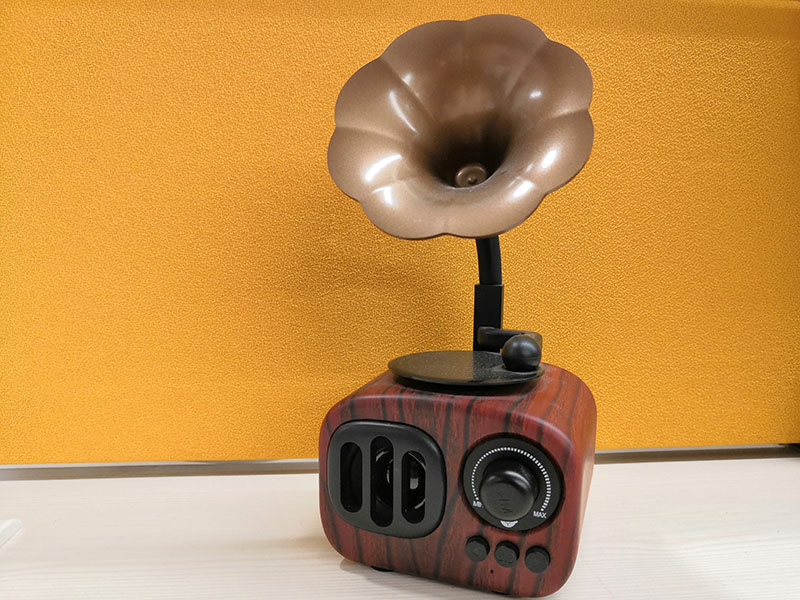

























































Loved your review and the phone looks promising but it has not launched in India. Nova 3i launched couple of days back. Do you have any idea when can it be launched?
Please do indepth camera comparison of one plus 6 and zenfone 5z with nova 3. Because performance should not matter a lot in day to day use. And being second largest brand of world i am pretty sure of excellent after sale service from huawei.